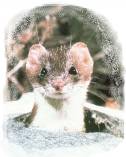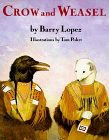| This site will look much better in a browser that supports web standards, but it is accessible to any browser or Internet device. |
Dancing with Badgers:
Weasel Words and Skulking Stoats
Who Are the Weasels?
The weasel subfamily includes weasels, minks, martens, ferrets, and the wolverine. There are three animals actually called weasels: the least weasel, the long-tailed weasel, and the short-tailed weasel. The short-tailed weasel is also called the ermine or stoat.
The long-tailed weasel has a dramatically long, thin tail like a cat's. The other differences among the three are too subtle for most of us. All three can turn white in the winter, but the ermine has a black tail tip that distinguishes its pelt from the least weasel's. Of course, so does the long-tailed weasel....

Bull Least Weasel
The size ranges for the ermine and the least weasel overlap nearly 100%, and in both species, males can be twice the size of females. In other words, a female ermine may be half the size of a bull "least" weasel. There are slight differences in color, with the summer ermine more ginger to gold, and the least weasel more cinnamon.
Both the ermine and the least weasel, like the wolverine, are found throughout the northern hemisphere. The long-tailed weasel is found only in the Americas.
There is nothing meaner than a weasel, nor a worse stinker than a skunk. The skunk's bad press makes sense, but where we got the folk image of the weasel is beyond me. A little digging on the 'net, and you'll find a man whose father's ducks had their feet eaten off by weasels. All of them. In one night! And of course they suck blood. And eggs. And they kill their prey by cutting its throat and drinking the blood. Horrid things. Nasty, horrid things.
And heavily burdened with twaddle. The duck feet story, for example, is from an essay by Dr. Philip Hiscock, Folklore Archivist at Memorial University of Newfoundland, and although Dr. Hiscock is a certified folklorist, the article, which appeared in Newfoundland's Downhomer magazine, shows no signs of being tongue-in-cheek. He's serious, I think.
After announcing that weasels are "nature's psychopaths," Dr. Hiscock describes them as sneaky and vindictive and illustrates with the story of his friend, whose ducks' feet were eaten off — "all of them!" — in one night by, one is invited to imagine, a marauding gang of weasels. Who must have gone home, one assumes, with terrible tummy aches. (Duck feet? Bleckh!) Never mind that weasels are solitary; the only time you would see a "gang" of weasels, pace Kenneth Grahame, is when a mother was training the kids. And never mind, incidentally, that rats are gang animals and not above a bit of psychopathic duck nipping, and a bit more common than weasels. Dr. Hiscock knows the story is true, you see, because the same thing happened to his father!! No, really!
And they are obsessive, compulsive killers, these nasty bitey weasel thingies. Like, they get in the henhouse and kill all the hens, you know. This claim, in fact, has some truth in it. But it's a bit more complicated than the outraged pulpit of animal morality would have us believe.
Weasels: Nature's Psychopaths!!!
Weasels, like mice, can get through holes you could scarcely put your thumb through. A weasel gets into the hen house, and she kills a chicken. Do the other chickens go back to sleep and leave her to dine in peace? No. Can she drag her bonanza through a knothole no bigger than a quarter? No. Are the chickens thrashing about. yelling and screaming and generally raising the panic level to something resembling a fire alarm? Well, yes, actually, and Ms. Weasel loses her cool.
It's possible that the other element, the euphoria of finding abundant prey trapped, also plays a part. I suspect that the incidents of weasels "wiping out a henhouse" are similar in most respects to the incidents of wolves or coyotes wiping out corraled sheep. That is to say, possible and even true, but heavily augmented with folklore and motivated, when they do happen, by a number of factors besides "love of mayhem," just as the motivation for promoting the folklore can be, well, a bit suspect.
Naturalist and SUNY Buffalo Professor Gerry Rising has two essays on his Nature Watch web site dealing with weasels (both originally printed in Buffalo News). In the first, "The Villain in the Woodpile," he describes some of the common metaphorical associations with weasels. He reminds us that the common childhood image of the weasel for most of us is the nasty gang of "stoats" that take over Toad Hall at the end of The Wind in the Willows. He mentions the slang use of "weasel" as a verb meaning to "inform on." Although he is right that the verb "weasel" is pejorative, I think he may be getting "fink" mixed up with "weasel out," in the sense of "evade." An informer is a weasel, a sneak, but what he does isn't "weaseling." Dr. Rising also describes the origin of the term "weasel words" (equivocations) in the notion that weasels suck eggs dry, leaving the shell intact. His second column records some reader anecdotes about weasels, all of them positive rather than blood-chilling.

For a wonderful example of Indian-style talking critters, get Barry Lopez' Crow and Weasel, which turns up in remainder bins nationwide. His weasel is just a guy named Weasel. Except, well, he is a weasel....
The weasel may be, ounce for ounce, the most ferocious hunter on the planet. Her main competition would be the shrew, a creature even smaller. And there's the explanation, by the way, for their ferocity: their size. Smaller animals in general burn calories faster proportionally than larger ones. A shrew can starve, if I remember my data correctly, in twenty minutes. Similarly, hummingbirds must eat almost constantly to fuel their bodies. So, yes, of course, the weasel, smaller than an overweight hamster but big enough to notice (shrews are smaller than mice), is a voracious hunter. Time's a-wastin'!
I watched a weasel outwit, outrun, assault, subdue, and kill an adult rabbit once. The rabbit weighed between two and three pounds; the weasel about four ounces. That's an animal the size of half a banana taking down one bigger than your supermarket chicken.
Carolyn King's The Natural History of Weasels and Stoats is one serious book about the critters, but it's out of print (you can see her one-page summary elsewhere, though). Another, also out of print, is Bil Gilbert's The Weasels: A Sensible Look at a Family of Predators.
The Topics
- Dancing with Badgers — Introduction
- Learning Mink — The Beginnings of a Fascination
- Badgers? Dancing? — Where We Got "Dancing Badger," and How
- The Least Among Us — Weasels as Heroes and Villains
- Farrah Fawcett Ferret — The Black-Footed Ferret Who Loved Me
- Skunks May Be Mommies — My Niece Meets a Stereotype
- To the Last Wolverine — Encounters with the Spirit of the Wild
- Tanuki Kami Is a Dharma Bum — Raccoon, Badger, Tanuki: What Was Your Name Again?
- Who Are Those Guys? — A Survey of an Impolite Family

|
|